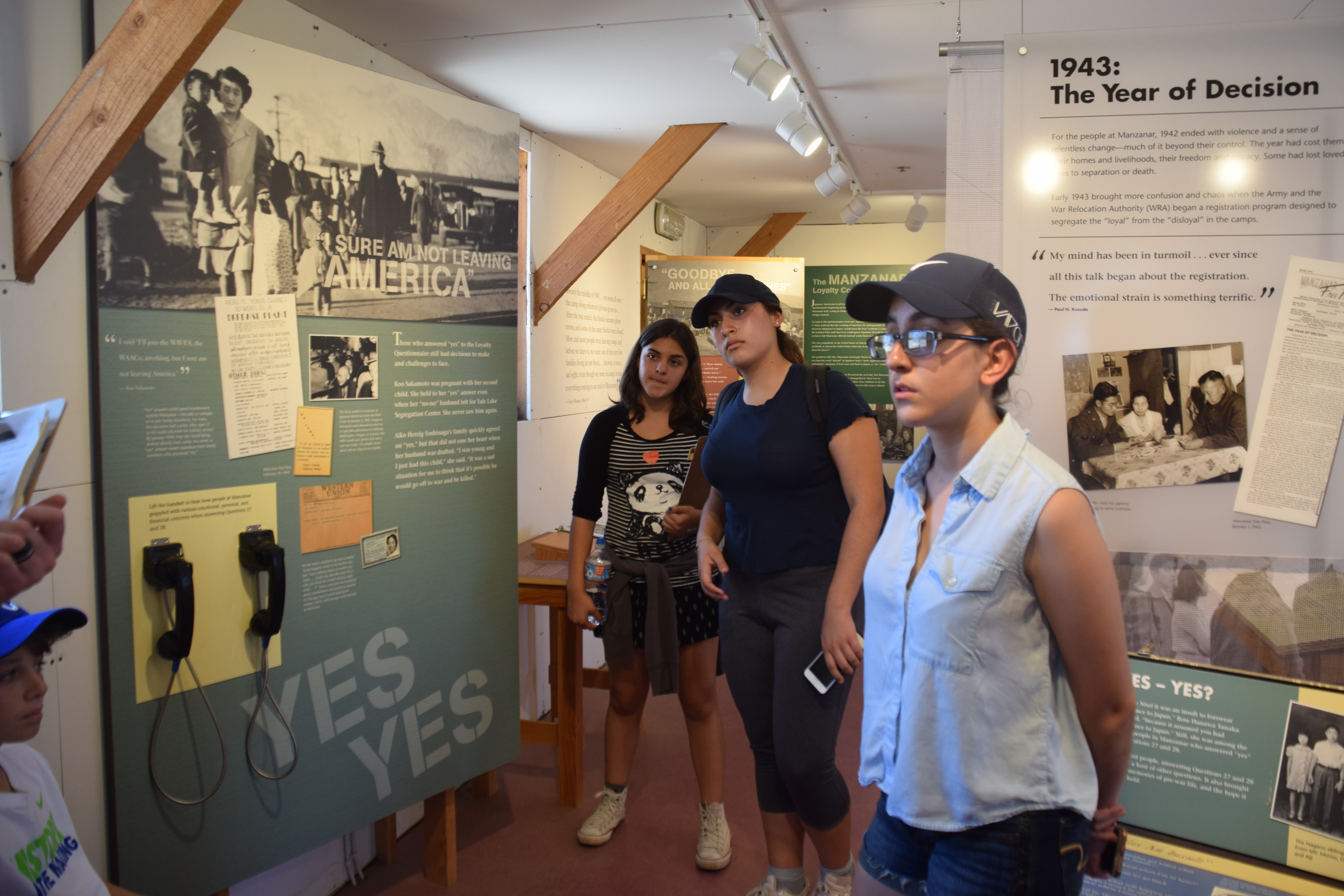Junior Interns Visit Manzanar Japanese Internment Camp

Last year, the USC Shoah Foundation Junior Interns traveled to Poland and visited Auschwitz-Birkenau State Museum to see one of the places where the hatred and inhumanity of the Holocaust was actually carried out.
This year, they went somewhere a little closer to home. For their annual field trip, June 26-27, eight members of the 2015-2016 cohort of Junior Interns visited Manzanar National Historic Site in Independence, Calif., where they discovered the United States’ own prejudice against Japanese Americans during World War II.
The USC Shoah Foundation Junior Interns are a group of 7th – 12th grade students who come to USC Shoah Foundation once a month to learn about testimony, tolerance, history, and how to be responsible participants in civil society. The Junior Intern program includes a trip to a museum or location that helps develop the students’ understanding of historical landscapes where hatred, intolerance and prejudice have had a destructive impact.
Manzanar National Historic Site is one of the ten internment camps established around the USA where thousands of Japanese Americans were forcibly relocated from 1942-1946.
On the first day of the two-day trip, the students met at the USC Shoah Foundation office in Los Angeles for an introductory lesson about Japanese internment in the United States during World War II. Led by Lesly Culp, instructor of the Junior Intern program and USC Shoah Foundation senior content specialist and trainer, the students discussed what they already know and wanted to learn about Japanese internment. They read newspaper headlines from the 1940s that revealed America’s strong distrust of first- and second-generation Japanese in the wake of the attack on Pearl Harbor.
Many students said they had never heard the term “Jap” before. They also noticed similarities in how politicians viewed the Japanese in the 1940s and how some cultural groups are viewed suspiciously today.
They also watched a clip from the testimony of Katsugo Miho, a Japanese American soldier who served in World War II. Miho described racism that he and his fellow Japanese soldiers faced from white soldiers in the military.
After a four-hour bus ride from Los Angeles to Independence, between Death Valley and Kings Canyon National Park, the students, Culp, and USC Shoah Foundation Education Project Specialist Greg Irwin arrived at Manzanar National Historic Site.
The tour began with a short film about the history and living conditions of Manzanar War Relocation Center for the thousands of Japanese Americans who were sent there. The group was then joined by a guide who showed them the museum exhibits and reconstructed barracks and answered the students’ many questions.
At the final stop, the reconstructed “mess hall” where the camp inmates would have eaten and prepared meals, the students engaged in a thoughtful discussion on what separated Japanese internment camps from concentration camps for Jews in Europe. What had prevented America from following in Germany’s footsteps, allowing the internees to maintain a small degree of humanity even as they were imprisoned in the camps against their constitutional rights?
“In genocides throughout history, a lot of times the people did not intervene,” William Masters said. “So I think people did intervene on both sides and that contributed to [the camps being humane].”
Gaelle Elalam suggested that once the fear and confusion of war had subsided after a few years, people began to realize that the internment camps should be closed.
Back on the bus, the students shared the most impactful thing they had seen or learned on the tour.
Frida Gaspar pointed out a photograph she had seen in the museum of a sign that proclaimed “Japs Keep Moving: This is a White Man’s Neighborhood.”
“That was really disgusting,” she said.
“I thought the little tag they gave each family member [with an identification number], I thought that was interesting because you weren’t referred to by your name, like in the Holocaust, however it stressed how they were trying to keep family members together and not separate them,” said Anna Hackel.
“Something that resonated with me were the basketball hoops, because it showed that even though they were in such horrible conditions they still found some small sources of joy,” said Gabriel Hackel.
Maya Marostica recalled the questionnaire that internees were forced to fill out that asked them if they were loyal to the United States and Japan. It forced people to make an impossible choice that would have repercussions for the rest of their lives.
Lucia Wiedeman mentioned the monument that was erected in the camp for the 150 internees who died at Manzanar, and appreciated the honor that was paid to these people. Claire Denault was moved by the paper crane chains that had been placed there.
“I know paper crane chains are part of Japanese culture and cranes represent healing,” she said.
Culp said she was glad the Junior Interns had gotten the chance to see firsthand the consequences of racism, misplaced fear and lack of critical thinking. She encouraged them to be inspired by the examples of people who had stood up to intolerance and refused to treat Japanese Americans like second-class citizens.
“If we had more people like that, even youngsters such as yourselves who could see a wrong and name it and call it out, we could make a difference,” Culp said.
Like this article? Get our e-newsletter.
Be the first to learn about new articles and personal stories like the one you've just read.